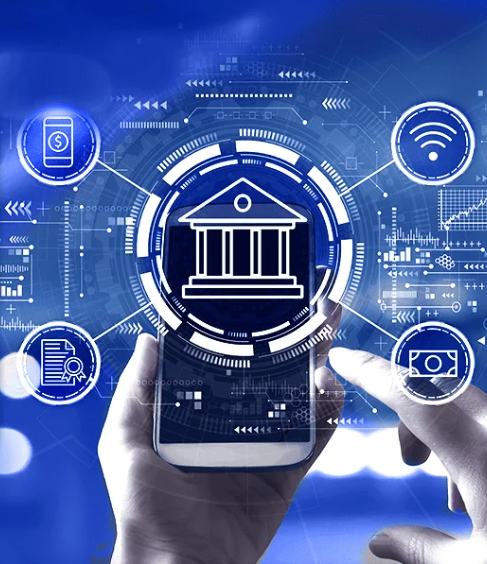The Evolution of Digital Banking: Shaping the Future of Financial Services

Digital banking has rapidly become a key player in transforming how we manage money today. This shift from traditional banking models to tech-based solutions has made financial services more accessible, faster, and user-friendly. With the rise of mobile apps, online platforms, and digital wallets, consumers are now able to handle their finances without stepping into a physical branch, all while enjoying an enhanced user experience.
Recent projections show that the global digital banking market could reach USD 12 trillion by 2030, nearly double its current size. This remarkable growth is driven by several factors, including the rise in smartphone usage, the increased demand for mobile payments, and the broad adoption of FinTech solutions in the financial services sector. In particular, regions like the Middle East and North Africa (MENA) are seeing notable FinTech growth, with 739 active FinTech companies in the region as of 2024.
In this post, we’ll dive into how digital banking is disrupting traditional banking, the reasons behind its explosive growth, the advantages it offers to both users and financial institutions, and the hurdles that need to be overcome. Additionally, we’ll explore how key players in the digital banking space are leveraging technology to empower the financial sector.
The Growth of Digital Banking
The digital banking sector has seen extraordinary growth in recent years. According to Statista, the number of digital banking users is expected to hit 386 million by 2028, marking an impressive 1,100% increase since 2017. The spread of smartphones, rapid advances in financial technology, and a growing trend toward digital-first lifestyles have all contributed to this surge. Consumers are increasingly choosing digital platforms for their banking needs, seeking the convenience, speed, and accessibility they offer.
The COVID-19 pandemic played a significant role in this transformation. With restrictions on physical movement, many consumers turned to online banking as their primary financial channel. This shift not only accelerated the adoption of digital banking but also underscored the importance of having efficient digital banking systems in place. Banks that had already embraced digital technologies were able to maintain customer loyalty, while others quickly adapted to meet rising customer demands for digital services.
The younger, tech-savvy generations, including Millennials and Gen Z, have also driven this shift. These consumers expect financial services to align with their digital lifestyles, valuing easy-to-use apps, instant transactions, and seamless online experiences. In response, both traditional banks and fintech companies have ramped up efforts to meet the needs of this demographic, which in turn fuels the continued growth of digital banking.
Key Features of Digital Banking
Digital banking platforms offer a range of innovative features designed to make financial management simpler and more efficient. Here are some of the key features that stand out:
- Omnichannel Accessibility
Digital banks ensure that customers can access their services seamlessly across devices, from smartphones to computers, allowing for a smooth banking experience. Whether starting a transaction on a mobile app or finishing it on a computer, users enjoy the flexibility to switch devices without losing progress. - Personalized User Experience
Today’s digital banking platforms use data-driven insights to provide tailored experiences. Personalized services such as custom financial advice, loan offers, and spending insights help build stronger customer relationships and foster loyalty. - Integration with Third-Party Services
By integrating with third-party tools like budgeting apps and e-commerce platforms, digital banks create an interconnected ecosystem that simplifies customers’ financial lives, offering an all-in-one solution for managing money. - Instant Payments and Transfers
Real-time payments and money transfers are now a standard feature in digital banking, enabling users to send and receive money with minimal delays, often at a lower cost than traditional methods. - Embedded Financial Services
Digital banking is expanding to include a variety of financial services directly within platforms. From insurance and loans to investments, customers can now access everything they need in one place. - Boundless Accessibility
The ability to manage finances from anywhere, at any time, is one of the greatest advantages of digital banking. This borderless access means users are no longer tied to physical bank locations or restricted by business hours. - Advanced Security Protocols
Ensuring security is a priority for digital banks. Advanced measures like biometric authentication, two-factor authentication, and real-time fraud detection protect users’ data and funds from unauthorized access. - Environmental Friendliness
Many digital banks are integrating features like carbon tracking to help users monitor the environmental impact of their transactions, encouraging more sustainable financial practices.
Advantages of Digital Banking
The convenience and flexibility of digital banking have contributed to its rapid adoption. Here are some of the key benefits customers enjoy:
- Convenience and Accessibility
Digital banking allows users to access their accounts and perform transactions at their convenience, from any location. This 24/7 access makes banking more convenient, especially for those with busy schedules. - Cost Savings
Many digital-first banks have lower operational costs, which are passed on to consumers through lower fees and better interest rates. This has forced traditional banks to rethink their pricing strategies, leading to more competitive rates. - Enhanced Financial Management Tools
Digital banking apps offer users a range of tools for budgeting, goal setting, and financial analysis. These resources help consumers make more informed financial decisions and improve their financial literacy. - Speed and Efficiency
Digital banking transactions are faster, allowing for quicker bill payments, transfers, and loan processing. Some platforms, like Digibanc, have reduced loan application times by up to 95%. - Better Security
With the latest security features, such as encryption and two-factor authentication, digital banking platforms are designed to keep users’ information and funds safe, reducing the risk of fraud.
Strengthening Security in Digital Banking
With digital banking becoming more widespread, ensuring security has never been more crucial. Financial institutions are investing heavily in advanced security technologies to protect against cyber threats. Encryption and multi-factor authentication are two of the main tools used to safeguard customer data. Regular updates and proactive security measures are essential to maintaining a secure environment as cyber threats continue to evolve.
Educating customers on security best practices is also a key aspect of creating a safe digital banking experience. By providing tips on password management and identifying phishing scams, financial institutions can help users protect their personal information.
Challenges and Risks in Digital Banking
Despite its many advantages, digital banking faces several challenges:
- Digital Divide
Not all consumers have equal access to the internet or digital devices. Older individuals or those in underserved regions may struggle with digital platforms, potentially excluding them from essential banking services. - Regulatory Complexity
Digital banks must navigate a patchwork of regulations, which can be complex and vary by region. Compliance with data privacy, anti-money laundering, and open banking rules can be challenging for digital-first institutions. - Cybersecurity Threats
As digital banking becomes more prevalent, financial institutions are increasingly targeted by cyberattacks. The industry must stay vigilant, investing in the latest technologies to fend off threats and maintain customer trust. - Customer Trust
Some customers remain hesitant to fully embrace digital banking due to concerns over security and the impersonal nature of online services. Financial institutions must work to address these concerns by providing clear communication, excellent customer support, and robust security measures.
The Future of Digital Banking
Looking ahead, digital banking will continue to evolve, with emerging technologies playing a crucial role in shaping the future. Artificial intelligence (AI) and machine learning are set to enhance personalization and security, while blockchain technology could revolutionize payments and data integrity. Open banking is also expanding, giving consumers more control over their financial data and enabling greater collaboration between fintech companies and traditional banks.
The future of banking is undoubtedly digital, and as traditional financial institutions continue to adapt to this shift, we can expect a more efficient, secure, and customer-centric banking experience.


 English
English 












































































































































































































































































































































































